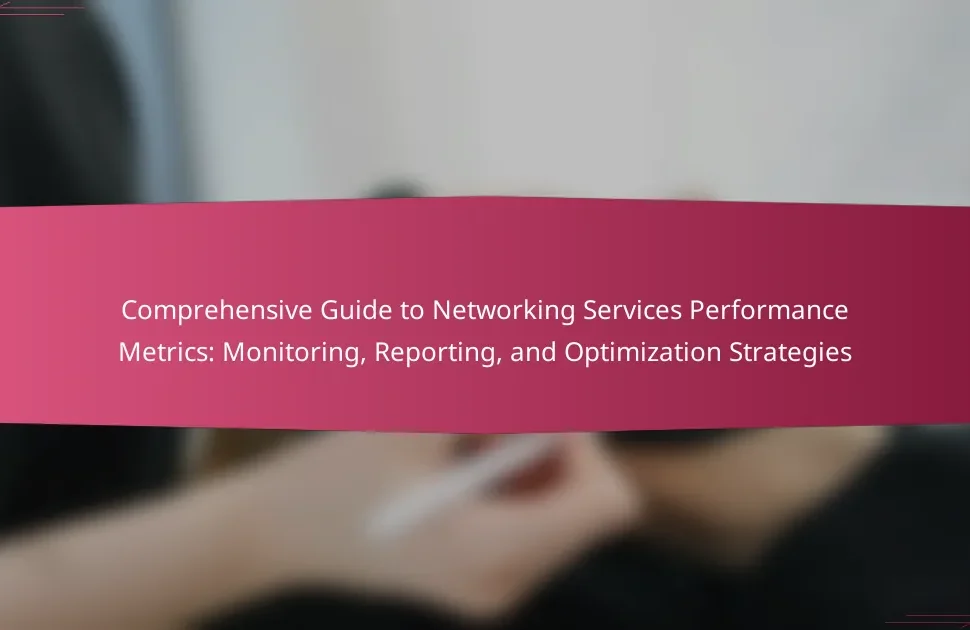
What are Metrics for Success in Networking Services?
Metrics for success in networking services include performance indicators, return on investment (ROI), and customer satisfaction. Performance indicators assess network reliability, speed, and uptime. For example, a common metric is network uptime, typically targeted at 99.9%. ROI measures the financial return from networking investments. A positive ROI indicates that the networking services contribute to overall profitability. Customer satisfaction metrics gauge user experience and service quality. Surveys and Net Promoter Scores (NPS) are often utilized to measure this. Competitive analysis benchmarks performance against industry standards. These metrics collectively provide a comprehensive view of success in networking services.
How do performance indicators define success in networking services?
Performance indicators define success in networking services by quantifying key aspects of performance. They measure metrics such as uptime, latency, and bandwidth utilization. High uptime indicates reliable service, while low latency reflects fast response times. Bandwidth utilization shows how effectively resources are used. These indicators provide benchmarks for assessing service quality. For instance, a network with 99.9% uptime is considered highly successful. Studies show that companies with effective performance indicators achieve 20% higher customer satisfaction. Thus, performance indicators directly correlate with operational success in networking services.
What are the key performance indicators (KPIs) used in networking services?
Key performance indicators (KPIs) used in networking services include bandwidth utilization, latency, packet loss, and uptime. Bandwidth utilization measures the amount of available bandwidth being used. Latency indicates the time it takes for data to travel from source to destination. Packet loss tracks the percentage of packets that fail to reach their destination. Uptime reflects the percentage of time the network is operational and available for use. These KPIs help assess the performance and reliability of networking services. Monitoring these metrics enables organizations to optimize network performance and improve user experience.
How do KPIs vary across different networking service providers?
KPIs vary across different networking service providers based on their specific service offerings and operational focus. For instance, some providers prioritize network uptime, measuring it as a percentage, while others may focus on customer satisfaction scores. Additionally, data throughput rates are often a key performance indicator for providers offering high-speed internet. Latency measurements can be critical for those targeting gaming and real-time applications.
Moreover, cost efficiency metrics, such as cost per gigabyte delivered, differ among providers based on their pricing strategies. Some may emphasize service level agreements (SLAs) that guarantee certain performance thresholds. Others might track the number of resolved support tickets as a measure of service quality.
These variations reflect the diverse priorities and customer needs that different networking service providers cater to.
Why is ROI important in evaluating networking services?
ROI is important in evaluating networking services because it quantifies the financial return on investment. This metric helps businesses determine the effectiveness of their networking expenditures. A positive ROI indicates that the benefits of the networking services exceed the costs incurred. For instance, a study by Cisco found that companies experienced a 20% increase in productivity after implementing advanced networking solutions. Additionally, ROI analysis allows for informed decision-making regarding future investments in networking infrastructure. By comparing ROI across different services, organizations can identify which solutions provide the best value. This ultimately leads to optimized resource allocation and improved overall business performance.
What methods are used to calculate ROI in networking services?
Methods to calculate ROI in networking services include the cost-benefit analysis, payback period, and net present value (NPV). Cost-benefit analysis compares the total expected costs against the total expected benefits. The payback period measures how long it takes to recoup an investment. NPV calculates the difference between the present value of cash inflows and outflows over time. These methods provide a structured approach to assess the financial effectiveness of networking investments. For instance, a study by Cisco found that businesses can achieve a 300% ROI on networking upgrades within three years. This data supports the effectiveness of using these methods for calculating ROI in networking services.
How can businesses improve their ROI from networking services?
Businesses can improve their ROI from networking services by implementing targeted strategies. First, they should identify their networking goals clearly. This allows for focused efforts that align with business objectives. Second, leveraging data analytics helps in understanding customer interactions and improving service offerings.
Third, fostering strong relationships with clients can lead to repeat business. According to a study by Bain & Company, increasing customer retention by 5% can boost profits by 25% to 95%. Fourth, investing in employee training enhances the effectiveness of networking efforts.
Additionally, utilizing CRM systems can streamline communication and track interactions. This leads to more personalized services and higher customer satisfaction. Lastly, regularly reviewing networking strategies ensures they remain effective and aligned with changing market conditions.
What role does competitive analysis play in networking services?
Competitive analysis plays a crucial role in networking services by identifying market trends and competitor strategies. It helps organizations understand their position in the industry. This analysis informs decision-making and strategic planning. Companies can leverage insights to enhance their service offerings. Competitive analysis also aids in identifying gaps in the market. By understanding competitors’ strengths and weaknesses, businesses can differentiate their services. Research indicates that companies engaging in regular competitive analysis outperform those that do not. According to a study by the Harvard Business Review, firms that analyze competitors are 30% more likely to achieve their strategic goals.
How can competitive analysis inform strategic decisions in networking?
Competitive analysis can inform strategic decisions in networking by identifying industry trends and benchmarking performance. It helps organizations understand their competitors’ strengths and weaknesses. This insight allows for better positioning in the market. For example, analyzing competitors’ service offerings can reveal gaps in the market. Companies can then tailor their services to meet unmet needs. Additionally, competitive analysis aids in pricing strategies by comparing competitor pricing. This ensures that pricing remains competitive while maximizing profitability. Ultimately, leveraging competitive analysis leads to informed decision-making and strategic advantage.
What tools are available for conducting competitive analysis in networking services?
Tools available for conducting competitive analysis in networking services include SEMrush, Ahrefs, and SimilarWeb. SEMrush provides insights into competitors’ traffic and keyword strategies. Ahrefs allows users to analyze backlinks and SEO performance. SimilarWeb offers detailed traffic sources and engagement metrics. Other tools include NetBase for social media analysis and G2 for software reviews. These tools help identify market trends and assess competitive positioning.

How can businesses effectively measure their networking service success?
Businesses can effectively measure their networking service success by utilizing key performance indicators (KPIs). These KPIs include metrics such as user satisfaction, service uptime, and response time. User satisfaction can be assessed through surveys and feedback forms. Service uptime is typically monitored through system logs and performance tracking tools. Response time can be evaluated by measuring the speed of issue resolution.
Additionally, businesses should analyze return on investment (ROI) related to networking services. This involves comparing the costs of networking services against the financial benefits gained from improved productivity and customer satisfaction. Competitive analysis can also provide insights into how a business’s networking services perform relative to industry standards.
According to a report by Gartner, organizations that effectively measure these metrics can improve their service quality by up to 30%. Therefore, consistent tracking and analysis of these KPIs are crucial for determining networking service success.
What are the common challenges in measuring networking service success?
Common challenges in measuring networking service success include defining clear metrics and benchmarks. Many organizations struggle to establish specific performance indicators that accurately reflect service quality. Additionally, data collection can be inconsistent or incomplete, leading to unreliable results. Stakeholder alignment is often lacking, causing discrepancies in perceived success. Furthermore, the dynamic nature of networking services complicates long-term measurement. External factors, such as market changes, can also impact the assessment. Lastly, the complexity of technology can hinder effective analysis of performance data. These challenges collectively make it difficult to gauge the true success of networking services.
How can businesses overcome these challenges?
Businesses can overcome challenges in networking services by implementing clear performance indicators. Establishing specific metrics helps in tracking progress and identifying areas for improvement. Regularly reviewing these metrics allows businesses to adapt strategies effectively. Investing in training for staff enhances their ability to utilize networking tools. Utilizing advanced analytics can provide insights into customer behavior and service performance. Collaborating with industry experts can offer innovative solutions to persistent issues. Furthermore, fostering a culture of continuous improvement encourages proactive problem-solving. These strategies are essential for maximizing ROI and maintaining competitive advantage in networking services.
What best practices should be followed for accurate measurement?
Accurate measurement in networking services requires adherence to best practices. First, define clear objectives for what you intend to measure. This ensures that the metrics align with your goals. Second, utilize standardized measurement tools and methodologies. Consistency in tools allows for comparability over time. Third, ensure data quality by validating and cleaning data before analysis. High-quality data leads to reliable insights. Fourth, establish a regular measurement schedule. Consistent intervals help track performance trends effectively. Fifth, involve stakeholders in the measurement process. Their insights can enhance the relevance of the metrics. Finally, analyze results in the context of industry benchmarks. This provides a frame of reference for evaluating success. Following these best practices enhances the accuracy and reliability of measurements in networking services.
How do different industries approach metrics for networking services?
Different industries approach metrics for networking services based on their specific operational needs and objectives. For example, the telecommunications sector emphasizes network uptime and latency to ensure service reliability. In contrast, the IT industry focuses on bandwidth utilization and data transfer rates to optimize system performance. The healthcare sector prioritizes metrics related to data security and compliance due to regulatory requirements.
Retail industries often measure customer engagement metrics, such as connection speed during online transactions, to enhance user experience. Financial services track transaction speed and reliability metrics to maintain customer trust and satisfaction. Each industry tailors its metrics to align with its unique challenges and goals, ensuring that the networking services effectively support their core functions.
What unique metrics are relevant for specific industries?
Unique metrics vary by industry, reflecting specific operational needs and goals. In the technology sector, metrics like uptime and response time are critical. The healthcare industry prioritizes patient outcomes and readmission rates. In retail, conversion rates and average transaction value are essential. For manufacturing, metrics such as production efficiency and defect rates are significant. The financial services sector focuses on metrics like return on assets and customer acquisition cost. Each industry has tailored metrics that provide insights into performance and guide strategic decisions.
How do industry standards influence networking service metrics?
Industry standards significantly influence networking service metrics by providing benchmarks for performance evaluation. These standards help define key performance indicators (KPIs) that organizations use to measure service quality. For example, standards like ITU-T Y.1540 define metrics for network performance, including latency and packet loss. Adhering to these standards ensures consistency in measurement across different providers. This consistency allows for accurate comparisons and competitive analysis. Furthermore, industry standards often drive improvements in technology and practices. As a result, they influence service providers to enhance their offerings to meet or exceed these benchmarks.

What are the future trends in networking service metrics?
Future trends in networking service metrics include increased automation, enhanced real-time analytics, and a focus on user experience. Automation in data collection and analysis will streamline processes and improve accuracy. Real-time analytics will enable quicker decision-making and proactive network management. Emphasis on user experience will drive metrics that assess customer satisfaction and service quality. Additionally, integration of AI and machine learning will enhance predictive analytics capabilities. These trends reflect the industry’s shift towards more agile and responsive networking solutions.
How is technology changing the landscape of networking metrics?
Technology is significantly transforming networking metrics by enabling real-time data analysis and automation. Advanced tools now allow for the continuous monitoring of network performance. This shift leads to more accurate and timely insights into network health. Automation reduces human error and speeds up the identification of issues. Machine learning algorithms enhance predictive analytics for better decision-making. Additionally, cloud-based solutions provide scalable metrics tracking across diverse environments. The integration of IoT devices expands the range of metrics available for analysis. These advancements collectively improve network reliability and user experience.
What emerging technologies are impacting performance measurement?
Emerging technologies impacting performance measurement include artificial intelligence, big data analytics, and the Internet of Things (IoT). Artificial intelligence enhances data analysis by providing predictive insights. Big data analytics allows for the processing of vast amounts of data in real-time. The Internet of Things connects devices, enabling continuous performance monitoring. These technologies improve accuracy in measuring key performance indicators. For instance, AI-driven tools can analyze user behavior patterns effectively. According to a report by McKinsey, companies using big data analytics can achieve a 5-6% increase in productivity. These advancements lead to more informed decision-making in networking services.
How can businesses adapt to these technological changes?
Businesses can adapt to technological changes by embracing digital transformation. This involves integrating advanced technologies into their operations. Companies should invest in training employees on new tools and systems. They must also prioritize data analytics to inform decision-making. Implementing agile methodologies can enhance responsiveness to market shifts. Collaborating with technology partners can provide access to innovative solutions. Regularly assessing technology performance metrics is crucial for ongoing improvement. Research shows that businesses that adapt effectively can increase their ROI by up to 30%.
What practical tips can enhance networking service metrics evaluation?
Establish clear objectives for networking service metrics evaluation. Specific goals guide data collection and analysis. Utilize standardized metrics to ensure consistency in evaluation. Metrics such as uptime, latency, and throughput provide measurable insights. Regularly review and update metrics to adapt to evolving networking needs. This practice ensures relevance and accuracy in evaluation. Implement automated monitoring tools for real-time data collection. Automation reduces human error and enhances data reliability. Engage stakeholders in the evaluation process for broader perspectives. Stakeholder input can identify additional metrics and improve overall evaluation quality.
How can regular reviews improve networking service performance?
Regular reviews enhance networking service performance by identifying inefficiencies and areas for improvement. These assessments allow for the monitoring of key performance indicators (KPIs) such as latency, bandwidth usage, and error rates. By analyzing these metrics regularly, service providers can optimize resource allocation and enhance overall network reliability. Furthermore, regular reviews facilitate proactive troubleshooting, which minimizes downtime and service disruptions. According to a study by the International Journal of Network Management, organizations that conduct regular performance reviews experience a 30% reduction in network-related issues. This data underscores the importance of consistent evaluation in maintaining high service standards.
What role does employee training play in optimizing metrics evaluation?
Employee training is essential for optimizing metrics evaluation. It equips employees with the necessary skills to accurately interpret data. Trained employees can identify key performance indicators effectively. This leads to more informed decision-making. Additionally, training fosters a culture of continuous improvement. Employees learn to adapt to changing metrics and industry standards. Research indicates that organizations with robust training programs see a 24% increase in productivity. This directly correlates with improved metrics evaluation outcomes.
Metrics for success in networking services encompass performance indicators, return on investment (ROI), and customer satisfaction. Key performance indicators include uptime, latency, and bandwidth utilization, which collectively assess network reliability and user experience. ROI analysis quantifies the financial return from networking investments, aiding businesses in optimizing resource allocation. Additionally, competitive analysis benchmarks performance against industry standards, informing strategic decisions and enhancing service offerings. The article further explores unique metrics relevant to various industries and the impact of emerging technologies on performance measurement.




